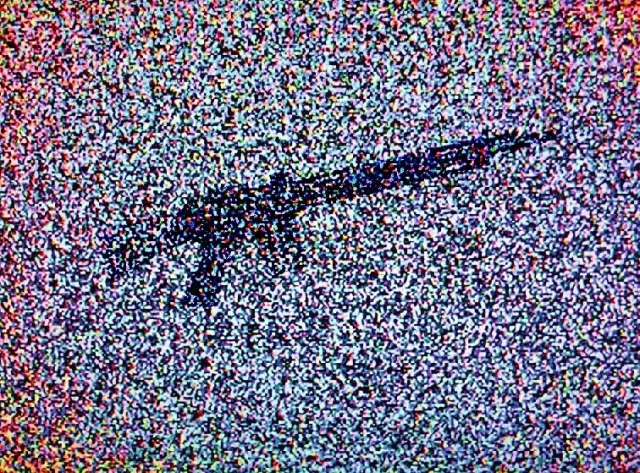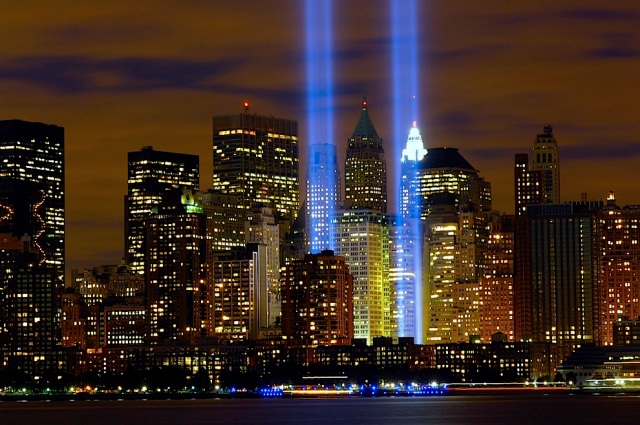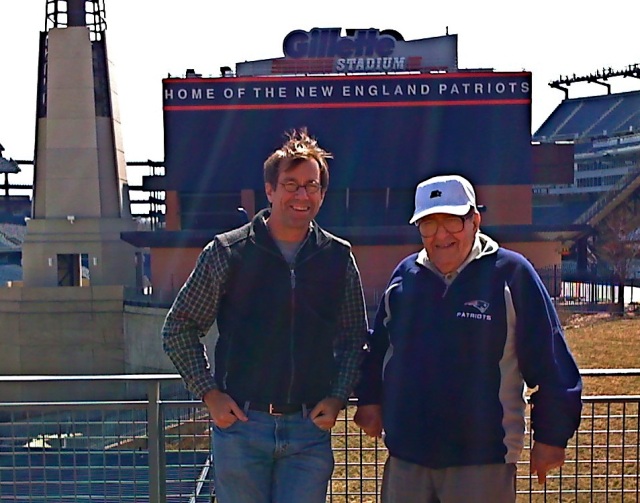Preface
No, this piece is not about Kelly Clarkson’s current Top 40 hit, “Stronger,” though I’m gladdened by its success, especially because of Clarkson’s popularity among gay, lesbian, bisexual, transgendered, and questioning youth. This essay is about my father and me, how our relationship changed over time, and about the prevailing power of love.
But if that all sounds rather sugary and sweet, then maybe we should go back to that Kelly Clarkson song for a moment and track down the source of its anthemic chorus, “What doesn’t kill you makes you stronger.” Kids and pop culture connoisseurs of America, welcome to the world of Friederich Nietzsche. Yes, the German philosopher who introduced us to the dark concept of “nihilism” provided the original inspiration for Clarkson’s current hit with this quotation: “That which does not kill us makes us stronger.” Before Nietzsche went insane toward the end of his life, he penned some of the most revolutionary remarks in modern philosophy, including this one: “To live is to suffer, to survive is to find some meaning in the suffering.”
I’ve been meditating on those two statements after reading Sabrina Rubin Erdely’s astonishing “School of Hate: One Town’s War on Gay Teens” in Rolling Stone Issue 1150 (Feb. 16, 2012; link below), continuing to think about the Rutgers suicide (referenced in my last blog), and struggling to come to terms with the murder of Trayvon Martin in Florida. I was also inspired by New York Times columnist Frank Bruni’s op-ed recognition of the founding of ACT UP by Larry Kramer 25 years ago this month (“The Living after the Dying;” link below). During the rewriting of this piece, another of Bruni’s columns, “Rethinking His Religion,” likewise moved me deeply, as did Maureen Dowd’s piece on fathers and sons, “How Oedipus Wrecks.” (Links to both are also posted below.)
I mention these sources to provide context in advance of sharing something that is quite deeply personal. Only a handful of people have heard some of these stories, and I continue to wrestle with their influence and consequences today. I withheld some details while my parents were alive but find that now, in grieving for them, pathways to the past that were once blocked off are now open for travel once again.
Suicide, murder, death by disease: How do we confront and survive such horrors in the world, especially those that are motivated and/or perpetuated by forces that are sometimes close to home, such as racism and homophobia? For me, the answer has always been clear. One at a time, we share our stories and experiences, both real and imagined. We listen, and then we respond. Together, we learn about lives different from our own—through fiction, poetry, music, painting, and every other creative endeavor. In developing our senses of empathy and understanding, we do what we can to make the world a better place.
This, then, is my personal response to many of the tragedies we have heard about in the news recently. It is a true story of survival and redemption, an exploration of how one person (me) found the strength to endure in such difficult and often dangerous times.

"Encounter/Exposure" — Multiple-exposure self-portrait taken back in the day.
What Didn’t Kill Me
“They should all be rounded up, taken into a field, and shot.”
That was my father back in the late 70’s, responding to a news story about Dade County, Florida, and the ordinance it had passed prohibiting discrimination on the basis of sexual orientation. Citrus Queen Anita Bryant was no doubt on the television stirring up homophobic sentiment among the growing crowds who had come to hear her rally against the ordinance under the guise of the innocent-sounding group “Save Our Children.” The homosexuals, Bryant shouted into her microphone, must be stopped. My father obviously agreed.
At the time, I didn’t fully understand what homosexuality was, even though I had some inkling that it was manifesting itself within me. “Fag,” “gay,” and “queer” were insults regularly hurled at me in school, not because I displayed any overt sexual interest in men, but because I was younger, weaker, and smarter than most of my peers. “Fag,” “gay,” and “queer” were also insults regularly sneered by Archie Bunker on the classic sitcom “All in the Family.” Archie was something of a hero for my father, and to this day, I doubt that he fully understood that the character was intended as a parody, his prejudices a cause for ridicule. When I would come home crying after occasional fights and beatings, my father would sternly advise me to “fight back like a real man.” It was clear to me that, in his eyes at least, I was at risk for becoming something “other” than a man.
I worked on developing a tough outer shell during my school years, mostly by immersing myself in music and shutting out the rest of the world. A quick look at my cassette mixes of the period reveals an obsession with punk rock and goth music. The glittering gaiety of disco held no interest or sway with me. I wanted rhythms and melodies that were darker and more complex, more in keeping with my shaded heart. I favored love songs in which the pronouns and protagonists were gender-neutral.
In my blue-collar hometown, there were no “gay, lesbian, bisexual, transgendered , and questioning youth” clubs or alliances in school. (N.B.: I’ll be shortening that list of identifiers to the commonly used “GLBTQ” throughout this entry, with apologies to those who question the arrangement of those letters.) There was no “welcoming congregation” in any of the local churches. I knew only one openly gay person, a disco-obsessed coworker with crude mannerisms who often showed up at work either drunk or stoned. There was no Web or Internet to provide any additional information about homosexuality or to engage in any social networking. There was mostly the television, with its occasional news story about gay-bashing and raids on “deviant sex clubs,” and my father’s vocal support of killing all the queers that the cops rounded up. Though I suspected that she disagreed, my mother remained silent.
I would often retreat to the basement or my bedroom, playing strange and obscure albums I had heard and read about during my job at a local music store. These would become the soundtrack to my adolescent dialogues with God, the ones in which I prayed for a change in my character while simultaneously praying for the cute guy in calculus class to notice me, the ones in which I would ask God why He had made me the way I was if my existence supposedly offended Him. If, as my mother had taught me, God was the source and sum of all human love, why was my love not a valid part of that equation?
One night, during my senior year, I concluded that there was no possible reconciliation between who I was and who I should be. Despite all the high grades in school and my teachers’ reports of exemplary conduct, I was more evil than good. I was a blot in God’s perfect world, an aberration, a mistake. Maybe, I thought, my father was right. Maybe people like me were better off dead.
And so, on a sudden impulse, I reached for the nearest weapon I could find—in this case, a dagger hanging on my bedroom wall. To be honest, it was a decorative dagger, purchased during a school-sponsored trip to Spain a year earlier. Even so, it was metal and its point was sharp. It would certainly do the trick. Without any second thoughts, I closed my eyes, held the dagger out with both hands, and plunged it toward my heart.
The heels of my hands punched into my chest. There was pain, but not the deep stab I’d expected. It felt more like a tiny bite, a bee-sting.
I looked down to see the blade bent flat and harmless against my chest. The tip had drawn blood, but left little more than a nick in the skin.
Inside, I heard a voice: “No, not this. Not you.” God was speaking directly to me. In that instant, I had found a faith deeper and truer than any I had previously known. My beliefs no longer relied on old-world hand-me-downs from parents and priests. I had just witnessed an actual miracle, a real-life experience imbued with divine grace and meaning. (Some years later, a college physician would explain the “miracle” in more clinical terms: I have an unusual bone spur located directly beneath my sternum, an abnormality that had been either absent or at least undetected throughout my entire life. Make of that what you will.)
To this day, I don’t know who or what had prevented my suicide—and yes, let’s be honest; that’s the word for what I had attempted. Even so, whatever happened that day left me with a renewed awe and reverence for this extraordinary gift of life.
In other words, it made me stronger.
Getting Stronger
Fast-forward to the University of Montana in the early 90s. A lesbian couple and I had been invited into a sociology classroom to discuss whether GLBTQ people should be allowed to adopt children. At the time, I was a graduate student in the English department, an “out” gay man to most of my friends and colleagues yet not to the students in the composition classes I taught.
A woman near the back raised her hand. “I don’t have any problem with you all being gay and what not,” she said. “But I just don’t think it’s fair to do that to the kids.” She paused, perhaps waiting for a murmur of support from her classmates. “I mean, the other kids would just tease them and make fun of them. It just wouldn’t be fair to the children.”
Ah yes; the children. Recollections of Anita Bryant sparked a prickly heat in my chest, but I tried to remain cool and calm on the outside. In the most even tone I could muster, I asked the woman, “Would that be your kids doing the teasing? Because I fail to see how someone else’s bad parenting skills should suddenly become my problem and prevent me from raising my own children with the decent values I intend to teach them.”
The woman squirmed in her seat. I could imagine her offense at my remarks: This class was supposed to be about queer people and their homosexuality, not straight people and their homophobia. Inasmuch as I was tired of straight people talking like experts about homosexuality, I was also tired of being a homosexual asked to talk about homophobia. Why did the task of dealing with gay-bashing—and other examples of bias-based violence, to some extent—always seem to get shoved back onto the backs of the targets of such violence? Hadn’t we been burdened with enough in our lives?
Yes, we had. But then, as I witnessed time after time among a number of GLBTQ friends and allies, we were that much stronger because of it. Through mutual support and sheer determination, we had weathered multiple storms and faced the next ones head-on. We had the courage of our convictions and the strength of our beliefs—convictions and beliefs that had been tested repeatedly, with all of that resulting in a hard-won faith in our God-given characters and abilities.
I recalled that sociology-class encounter as I read a Rolling Stone article about a recent string of teen suicides in the Annoka-Hennepin school district in Minnesota. The story received national attention primarily because of the district’s representative, former presidential candidate Michele Bachmann, and her Bryant-like crusade against homosexuality. She and her cohorts had promoted policies within the school district that prohibited any mention or discussion of homosexuality, even when it was crucial to addressing any instances of bullying or harassment. Sensitive GLBTQ students understood the underlying message: homosexuality was a sin, an evil in society, a sickness so despicable that it should not even be discussed, in public or in private. In a twisted logic reminiscent of rape cases in which the victims are blamed for provoking the attack, these students were advised to tone down their own behaviors and just be more careful around bullies. One victim noted that while teachers reprimanded students who used racial slurs, homophobic insults went unchallenged.
Recent protests around both the Annoka-Hennepin suicides, the Trayvon Martin murder, and other tragedies show that many people in society—perhaps even the majority, at long last—are sick of suffering such losses in silence. In calling for an end to toxic mindsets like homophobia and racism, justice-seeking people are now standing their ground and demanding that the law protect them from real threats such as armed vigilantes and over-zealous politicians. Community organizers and activists continue to work to create a safer, saner, and more supportive world for the next generation—not one in which ignorance masquerades as authority in order to diminish or extinguish the lives of others.
For years after coming out as a gay man, I had been working to achieve similar peaceful goals. In addition to organizing support groups for GLBTQ youth, I worked with the leaders of church congregations to make them more welcoming places. I wrote articles and edited a statewide GLBT newspaper. (“Q” wasn’t in the masthead at the time, and the arrangement of the other terms was always a hot-button topic.)
As a balance to activism, I engaged in some subversion as well. Together with a group of gay and lesbian cohorts, I infiltrated a local chapter meeting of noted homophobe Phyllis Schlafly’s Eagle Forum. At the end of that event, the chairperson came by to thank us for attending. “Your presence here tonight has really opened my eyes,” she said. I noted that all of us had recited the Pledge of Allegiance together at the start of the meeting, and that I for one proudly believed each and every word. “Liberty and justice for all,” I repeated, placing extra emphasis on “for all.” She nodded; she understood. Despite our initial fears of one another, we could connect after all.
In the weeks leading up to my father’s death last June, I told him many of these stories that I am telling you now. (I did not, however, tell him about the suicide attempt, nor about how his own behavior had played a major role in that.) I had been spending as much time with him as I could, trying my best to tolerate his constant cigarette smoking even as cancer, heart disease, and numerous other ailments waged war within his body.
It came as no surprise to me that in addition to football and baseball, some of his favorite television programs were courtroom reality shows: “Judge Judy, “ Judge Joe Brown,” “Judge Jeanine Pirro.” Every so often, a gay or lesbian plaintiff or defendant would take the stand. Their appearances on the show seemed quite normal and never elicited comment, positive or negative, from my father.
But then, just days before his death, my father delivered one final judgment.
We had just spent hours talking about love, sharing stories about the people who had mattered most to us in our lives while a Red Sox rebroadcast droned on in the background. After confessing our secret boyhood crushes, he glanced at the clock. “My God,” he said. “It’s way past midnight!”
Instead of wrapping up the conversation and saying our goodnights, my father raised his hand to hold my attention. “One more thing,” he said. He looked down at the floor, then back up at me. “You know, you’re a lot stronger than I ever gave you credit for. Don’t you ever let anyone take that away from you.”
His words came as a shock. I had never expected them. In fact, I had long ago convinced myself that I did not need them. Because of that, he and I had often kept our distance—both figuratively and literally. And yet, at long last, my father had looked deep inside me and approved of what was there.
This growing approval had been evident over many visits made by my husband and me. Together, the three of us had shared all sorts of stories, from my dad’s wartime adventures in the Phillipines to our relatively bucolic tales of life in Vermont. His happiness for us was genuine, especially when he heard that our friends and neighbors had fully accepted us into their small-town community.
No doubt, my father had feared it would be otherwise. He knew firsthand how strong a force prejudice and homophobia could be in the world. And yet now, at last, he knew another truth: a person could be stronger than that. The fact that I could be such a strong person is, I now realize—despite its tough and tortured origins—my father’s legacy to me.
Epilogue: “It Gets Better”
In response to the numbers of GLBTQ youth who are harassed and bullied in schools around the country, the writer Dan Savage recently utilized the power of YouTube to create inspirational videos in which speakers tell stories focused on the theme “It Gets Better.”
Though the story I have told above might sound like something you’d find there, I have to express my reservations about the project. I don’t mean to say that the thousands of stories told on the site aren’t helpful or valuable. They are, and I applaud each and every person who has added his or her positive voice to the site.
Even so, the phrase “It gets better” sounds so, well, weak to me. As a teenager, I was savvy to simplistic platitudes like that. They sounded like so much wishful thinking, Hallmark cards for the marginalized. What is the pronoun “it” referring to, anyway? And what kind of action verb is “get”?
I know, I know…the writer/editor in me shouldn’t be so fussy when lives are at stake.
But here’s the deal: Sometimes it doesn’t get better. Sometimes the boy doesn’t get the boy, the girls don’t get the adoption approval, or the operation doesn’t turn out the way someone had hoped. Hearing the words “it gets better” just makes it sound like we should all wait patiently and ride out the storm. It’s a passive construction, and, as the stories above should illustrate, I’ve had it with passive. In crisis situations, I crave more control of my life, not less.
So, in addition to (but not in place of) “It Gets Better,” I offer these words of support: “You Grow Stronger.” And if you don’t believe me, just listen to that Kelly Clarkson song again. Or read Friederich Nietzsche.
Better yet, I am proud to report, you can take my father’s word for it.
UPDATE:
Since the publication of the original article in Rolling Stone, the Anoka-Hennepin School District finally developed a better (though not perfect) policy in order to “promote a respectful learning environment” in its schools. You can read about the new policy here in their newsletter:
http://www.anoka.k12.mn.us/education/components/whatsnew/default.php?sectiondetailid=233410&itemID=45742
LINKS
“School of Hate” in Rolling Stone link:
http://www.rollingstone.com/politics/news/one-towns-war-on-gay-teens-20120202
Frank Bruni links:
“The Living After the Dying”
http://www.nytimes.com/2012/03/18/opinion/sunday/bruni-the-aids-warriors-legacy.html?_r=1&scp=2&sq=frank%20bruni%20ACT%20UP&st=cse
“Rethinking His Religion:”
http://www.nytimes.com/2012/03/25/opinion/sunday/bruni-a-catholic-classmate-rethinks-his-religion.html?_r=1&hp
Maureen Dowd: “How Oedipus Wrecks” link:
http://www.nytimes.com/2012/03/25/opinion/sunday/dowd-how-oedipus-wrecks.html?ref=opinion
“It Gets Better” link:
http://www.itgetsbetter.org/








